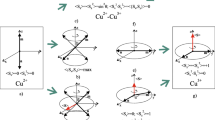Abstract
The key feature of parent cuprates of the La2CuO4 type, in addition to their high ionic polarizability and closeness to polarization catastrophe, is identified as their instability against charge transfer that is accompanied by the formation of a system of metastable dipole-active Mott–Hubbard excitons, i.e., electron–hole (EH) dimers. This feature determines the behavior of cuprates upon nonisovalent substitution. Within the simplest model equivalent to a system of composite bosons, nonisovalent substitution shifts the phase equilibrium toward condensation of EH dimers and the formation of inhomogeneous EH liquid. To describe the electronic state of doped cuprates effectively, we propose to use the pseudospin S = 1 formalism. It enables us to treat cardinally new charged states such as Anderson’s RVB phases. Recombination of EH dimers at a critically low energy of local and nonlocal correlations drives the system into the state of a Fermi liquid.



Similar content being viewed by others
REFERENCES
D. Reagor, E. Ahrens, S. W. Cheong, A. Migliori, and Z. Fisk, Phys. Rev. Lett. 62, 2048 (1989).
B. P. P. Mallett, T. Wolf, E. Gilioli, F. Licci, G. V. M. Williams, A. B. Kaiser, N. W. Ashcroft, N. Suresh, and J. L. Tallon, Phys. Rev. Lett. 111, 237001 (2013).
A. S. Moskvin, Phys. Rev. B 84, 075116 (2011).
A. S. Moskvin, Phys. Solid State 61, 693 (2019).
S. Ono, S. Komiya, and Y. Ando, Phys. Rev. B 75, 024515 (2007).
M. Ikeda, M. Takizawa, T. Yoshida, A. Fujimori, K. Segawa, and Y. Ando, Phys. Rev. B 82, 020503(R) (2010).
M. A. Kastner, R. J. Birgeneau, G. Shirane, and Y. Endoh, Rev. Mod. Phys. 70, 897 (1998);
M. Grüninger, J. Münzel, A. Gaymann, A. Zibold, H. P. Geserich, and T. Kopp, Europhys. Lett. 35, 55 (1996).
J. M. Ginder, M. G. Roe, Y. Song, R. P. McCall, J. R. Gaines, E. Ehrenfreund, and A. J. Epstein, Phys. Rev. B 37, 7506 (1988).
Y. H. Kim, S.-W. Cheong, and Z. Fisk, Phys. Rev. Lett. 67, 2227 (1991).
Y. Ando, Y. Kurita, S. Komiya, S. Ono, and K. Segawa, Phys. Rev. Lett. 92, 197001 (2004).
L. P. Gorkov and G. B. Teitelbaum, Phys. Rev. Lett. 97, 247003 (2006);
J. Phys.: Conf. Ser. 108, 12009 (2008).
T. Honma and P. H. Hor, Phys. Rev. B 77, 184520 (2008).
A. S. Moskvin, J. Phys.: Conf. Ser. 592, 012076 (2015);
J. Exp. Theor. Phys. 121, 477 (2015).
P. W. Anderson, Science (Washington, DC, U. S.) 235, 1196 (1987).
D. J. Scalapino, Rev. Mod. Phys. 84, 1383 (2012).
D. Wulferding, M. Shay, G. Drachuck, R. Ofer, G. Bazalitsky, Z. Salman, P. Lemmens, and A. Keren, Phys. Rev. B 90, 104511 (2014).
A. S. Moskvin and Yu. D. Panov, J. Supercond. Nov. Magn. 32, 61 (2019).
Funding
The work was supported within Program 211 of the Russian Government, agreement no. 02.A03.21.0006, by the Russian Ministry for Education and Science (project nos. 2277 and 5719).
Author information
Authors and Affiliations
Corresponding author
Ethics declarations
The author has no conflicts of interest.
Additional information
Translated by A. Kukharuk
Rights and permissions
About this article
Cite this article
Moskvin, A.S., Panov, Y.D. Electron–Hole Dimers in the Parent Phase of Quasi–2D Cuprates. Phys. Solid State 61, 1553–1558 (2019). https://doi.org/10.1134/S1063783419090178
Received:
Revised:
Accepted:
Published:
Issue Date:
DOI: https://doi.org/10.1134/S1063783419090178




